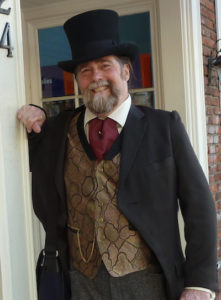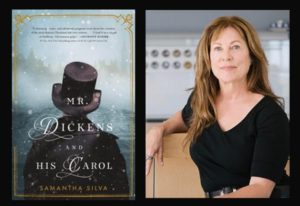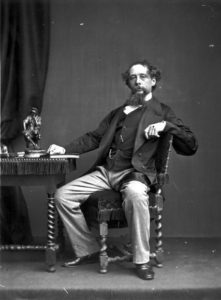English Culinary Insights in Delightful “Mr. Dickens and His Carol” Book
Samantha writes the book “as a fan letter – a love letter” and indeed it is a romanticized version of his life in London at the time.
And food is key to the mood of the moment. For example, Samantha’s historical premise is that when Dickens’ serialized novel Martin Chuzzelwit was a total flop, his publishers threatened that he would have to pay back his advance unless he wrote a successful Christmas novel. And this meant canceling the annual, extravagant holiday feasts at home, which much of the food already ordered.
At home, wife Catherine, who loved ten-course dinners, dictates Christmas dinner to the cook. “… four turkeys, a goose, mince pies, filberts, and candied fruits. A Christmas pudding, of course….”
“Christmas had been hiding in the streets all along,” she writes, even though Dickens is to the point of depression during the 1843 holiday season.
As Miss Silva describes it, “Shopkeepers stood on ladders, decking their windows with evergreen boughs. Old men roasted chestnuts in crowded courts; the pourer had a hand-painted sign for his goose-and-brandy club, the butcher his roast beef, the grocer his plum pudding. Never mind … that the air smelled like it had hailed nutmeg and snowed cinnamon,. Dickens couldn’t see or smell it.”
It is all part of how these streets and shops inspire and bring to life the spirit of Dickens’s stories, a favorite form of escape from his writing desk and bills at home. His long midnight walks around London – 20 miles at a time!
This is interspersed with a meal of every sort. At a dinner party of writers, “a guest leaves after the oyster patties but before the apple tarts.”
Tea was just beginning to be in vogue. Dickens was “surprised to find at one.. a low table laid with a fat pink rose on the side of each cup, hearts of lettuce, thin bread, butter, and pillowy scones baked that morning… and he suffered politely through conversation about ‘little tea,’ ‘low tea,’ ‘high tea’ and ‘handed tea.'”
This did not mean that after another dinner – and a miles-long walk, Dickens was not at the Saracens Head Inn “gobbling his breakfast of one plate of beef, another of shrimp, a hot kidney pudding, coffee, and claret.
Dinner is no less opulent. For one such dinner, Dickens settled for a dining room he often frequented, “stuffed into a little court out of Newgate Street… an old room.. heavy-paneled, dark, and dingy.. with a fire crackling away no matter the season. It had old-fashioned food and tidy waiters with limp white neckcloths who were always glad to leave him in peace for the prospect of a twopence at the end of the meal.” The menu read by the waiter was a “monotonous catalog” of roast beef, boiled pork, mutton chop, pigeon pie and rump-steak..with pastry or cheese for dessert.
To gain inspiration, Dickens visits his own London past. He finds himself in front of a decaying warehouse that once was workplace to an eleven-year-old Dickens when his father was in debtor’s prison and he, “a mere boy, worked ten hours a day, eating one stale pastry a day.”
When another ghost of the past, a former love, does inspire him, it also brings back the author’s appetite. On Christmas Eve day at Furnivals Inn, Dickens had “two tablespoons of rum with fresh cream for breakfast, a pint of champagne for tea, and two hours later a raw egg is beaten into a tumbler of sherry with a biscuit on the side.”
The meal was good preparation for the Dickens family feast, filled with family and literary friends, and news of his successful new book. “The long table was set magnificently, with tiered stands, flowers, and candelabras. ” The food was from wife Catherine’s list and more: “stuffed turkeys, a goose, oysters, mince pies, plum puddings, and Christmas cake, timbales, jellies, and molds, punch bowls of eggnog and smoking bishop. in the foyer, a magnificent tree nearly two floors tall was strung with candies, fruits, nuts, and trinkets, and a hundred lighted candles.”





 Gerry Furth-Sides
Gerry Furth-Sides  Barbara Hansen
Barbara Hansen  Chef-owner Alain Cohen
Chef-owner Alain Cohen  Roberta Deen
Roberta Deen  Jose Martinez
Jose Martinez  Nivedita Basu
Nivedita Basu